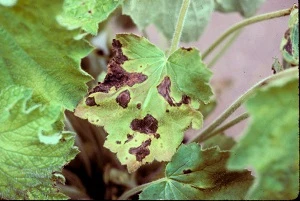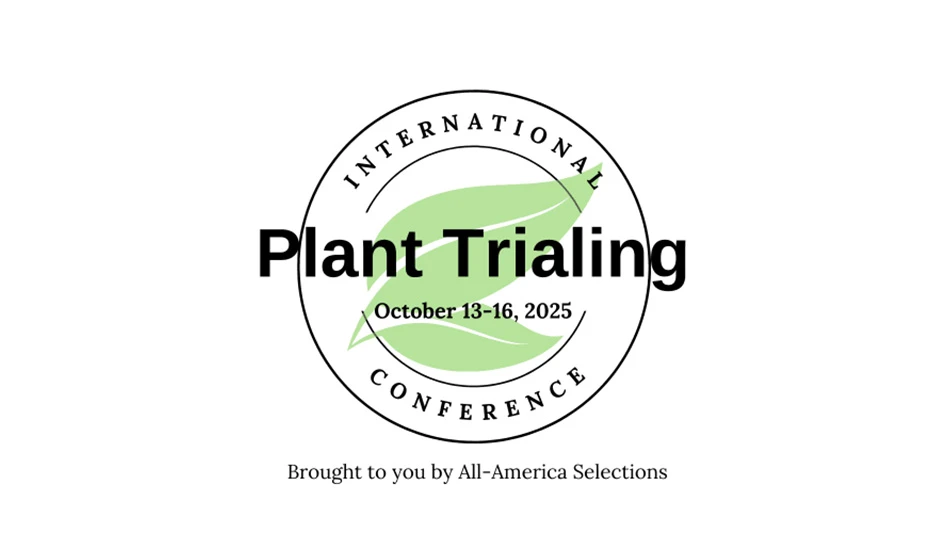
.jpg)
Photo:Leanne Pundt, University of Connecticut IPM
The spring growing season is upon us once again, and you know the crops on which you always fight foliar disease outbreaks. How many times have you had fungal or bacterial leaf spot or blight appear on your crop and wished that you had a preventive spray program in place that worked against these problems? Timing of fungicide applications is critical to their effectiveness against foliar fungi. The best times to apply foliar fungicides are when environmental conditions become favorable for disease development, when target pathogens are most vulnerable in their life cycles to fungicides, or both.
Most conventional fungicides act against pathogens using a single-site mode of action (MOA), which impacts a specific pathway of a pathogen life cycle or a component of disease development. Often, repeated and intense use of the same fungicide chemistry against a specific pathogen or pathogen group leads to the development of more tolerant or resistant pathogens in a cropping environment. Spray programs deploying multiple MOAs need to be used with good sanitation practices to preserve the effectiveness of conventional fungicides for years to come. Some of those MOAs included in such programs should be biological and/or biorational, as they offer mechanisms that control diseases by acting against pathogen growth, survival and activity at very physical and fundamental levels. These basic and sometimes brute-force MOAs are much less prone to resistance buildup.
MilStop and CEASE are two BioWorks products that should be included in foliar disease control programs, because they have more basic and broader modes of action than many other treatment options, which makes them great resistance management tools. MilStop is an EPA-registered, potassium bicarbonate-based foliar fungicide that kills powdery mildew on contact by pulling water from spores and their growing strands or hyphae. It also inhibits enzymes involved in fungal cell wall formation by altering the pH on the leaf surface. Based on a naturally occurring, patented strain of Bacillus subtilis (strain QST 713), CEASE provides effective control of a wide array of both fungal and bacterial pathogens, while providing outstanding plant, human and environmental safety. CEASE contains a group of natural antagonistic metabolites with multiple modes of action to destroy pathogens. CEASE is also an excellent tank-mix or rotational partner in your disease control program, compatible with most commonly used pesticides, nutrients and adjuvants. CEASE is also a great tank-mix partner for MilStop, with CEASE rates ranging from 2 to 8 quarts / 100 gallons and MilStop rates at 1.25 to 3.0 lbs /100 gallons depending on disease pressure and plant sensitivity.
A regular spray rotation with CEASE and MilStop can prevent the expression of botrytis and powdery mildew all season, not to mention bacterial leaf spots. They can also be incorporated into larger disease control rotations to help preserve the efficacy of more site-specific MOA synthetic chemistries. So, the questions you should ask yourself are: Are you feeling lucky? Can you afford to wait and see on disease control, hoping for nice spring weather without a foliar disease prevention program in place?
Why gamble on risking your spring crops to diseases? Shift the odds into your favor with a preventative foliar disease program of CEASE and MilStop.
Rich Reineke is Great Lakes Technical Sales Manager with BioWorks, Inc. Reach him at rreineke@bioworksinc.com.
Latest from Greenhouse Management
- Bug budget boom
- Don’t overlook the label
- Hurricane Helene: Florida agricultural production losses top $40M, UF economists estimate
- No shelter!
- Sensaphone releases weatherproof enclosures for WSG30 remote monitoring system, wireless sensors
- Profile Growing Solutions hires regional sales manager
- Cultural controls
- Terra Nova Nurseries shares companion plants for popular 2025 Colors of the Year





